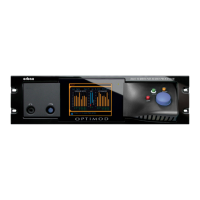OPTIMOD SURROUND PROCESSOR INTRODUCTION
1-19
Both meters are displayed simultaneously in 8685 PC Remote software.
The meter is scaled so that the loudness level at the consumer’s receiver is correct
when the 8685’s processing is adjusted to make dialog peak at “0 dB” on the
8685’s Loudness Level meter and the Dialnorm value (which you must enter
manually) in the active 8685 Setup is the same as the Dialnorm value being
transmitted to the consumer’s receiver. Because loudness perception combines
the contributions of all acoustic sources, there is only one Loudness Level meter
indication regardless of the number of audio channels.
The CBS meter is a “short-term” Loudness Level meter that displays the
details of moment-to-moment loudness with dynamics similar to a VU
meter. Created using Orban-developed modeling software, the DSP im-
plementation typically matches the original CBS analog meter within 0.5
dB on sinewaves, tone bursts and noise.
The Jones & Torick algorithm improves upon the original loudness meas-
urement algorithm developed by CBS researchers in 1967. Its foundation
is psychoacoustic studies done at CBS Laboratories over a two year period
by Torick and the late Benjamin Bauer, who built on S. S. Stevens’ ‘50s-
era work at Harvard University.
After surveying existing equal-loudness contour curves (like the famous
Fletcher-Munson set) and finding them inapplicable to measuring the
loudness of broadcasts, Bauer and Torick organized listening tests that
resulted in a new set of equal-loudness curves based on octave-wide
noise reproduced by calibrated loudspeakers in a semireverberant 16 x 14
x 8 room, which is representative of a room in which broadcasts are nor-
mally heard. They published this work
3
along with results from other
tests whose goal was to model the loudness integration time constants of
human hearing. These studies concentrated on the moderate sound lev-
els typically preferred by people listening to broadcasts (60 to 80 phons
4
)
and did not attempt to characterize loudness perception at very low and
high levels.
According to this research and its predecessors, the four most important
factors that correlate to the subjective loudness of broadcasts are these:
1. The power of the sound.
2. The spectral distribution of the power. The ear’s sensitivity depends
strongly on frequency. It is most sensitive to frequencies between 2 and 8
kHz. Sensitivity falls off fastest below 200 Hz.
3. Whether the power is concentrated in a wide or narrow bandwidth.
For a given total sound power, the sound becomes louder as the power is
3
Benjamin B. Bauer and Emil L. Torick, “Researches in Loudness Measurement,” IEEE
Transactions on Audio and Electroacoustics, Volume AU-14, Number 3, September
1966, pp. 141-151
4
The phon is a unit of perceived loudness, equal in number to the intensity in deci-
bels of a 1 kHz tone judged to be as loud as the sound being measured.

